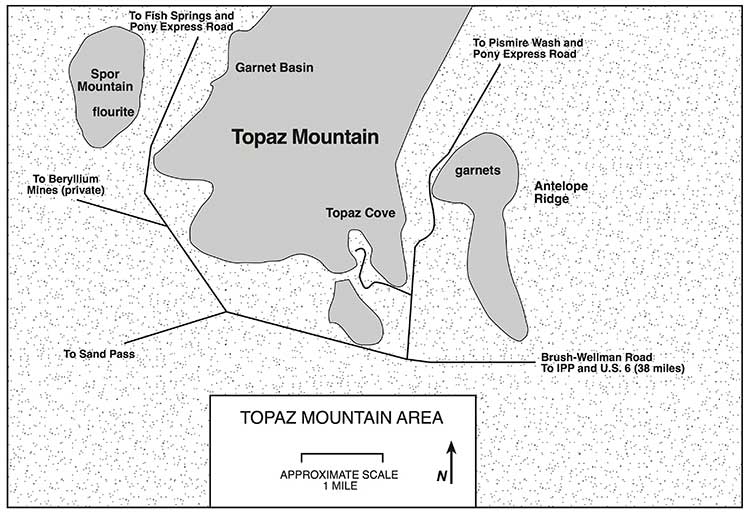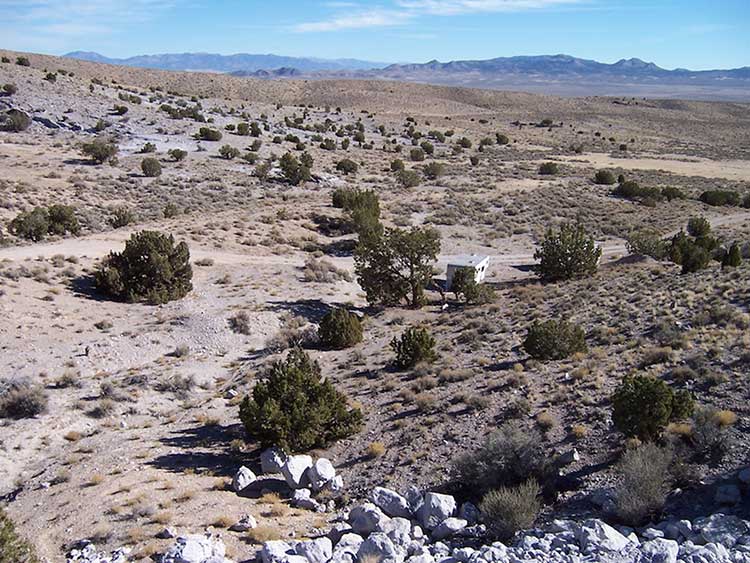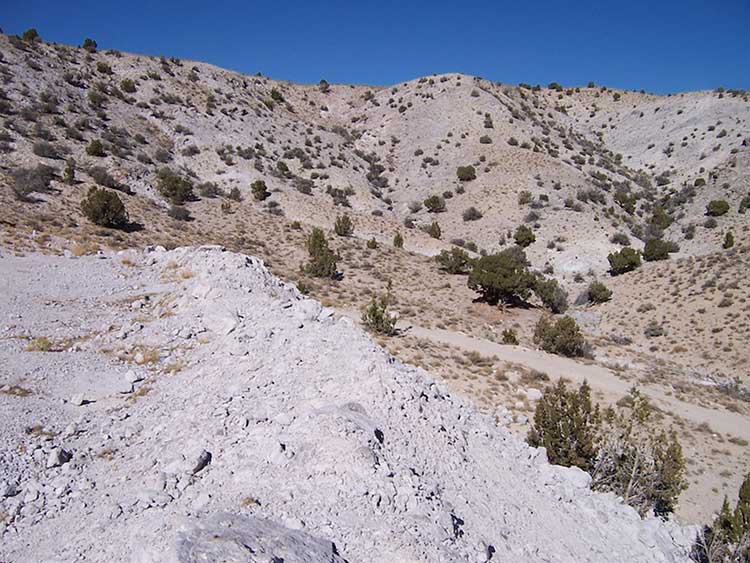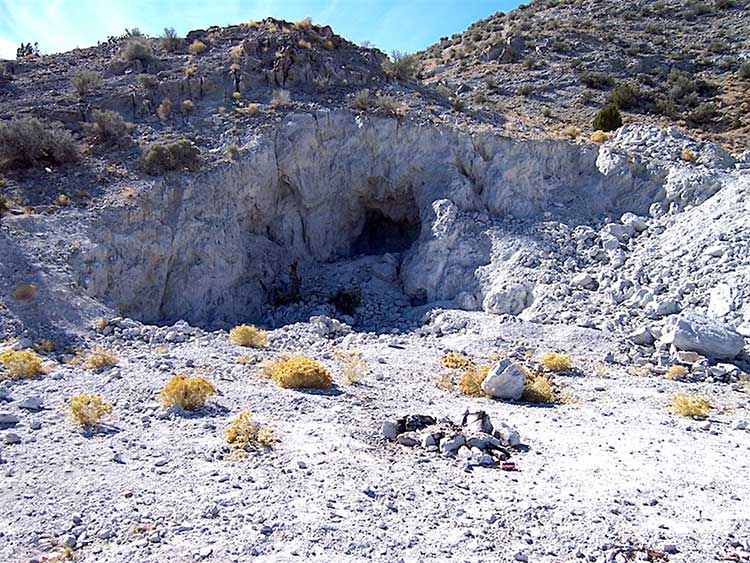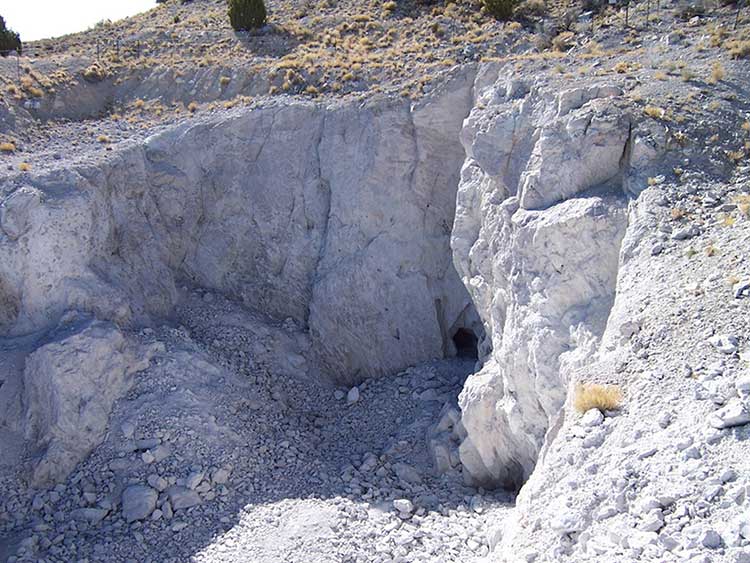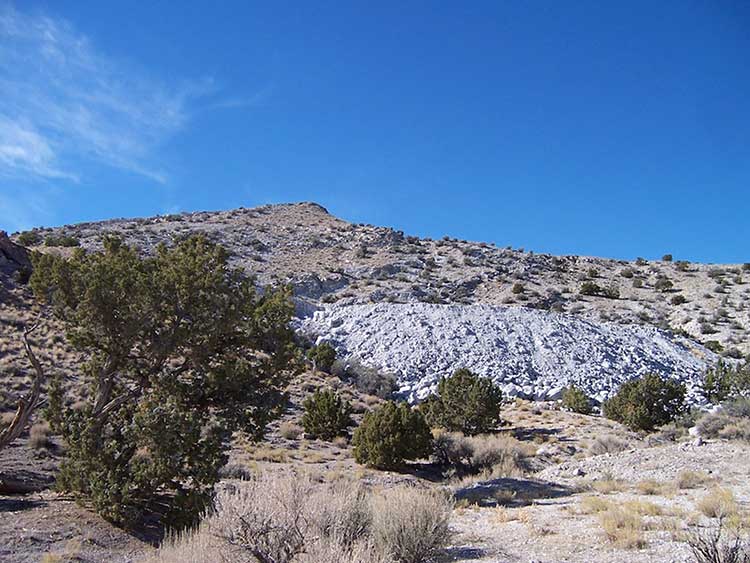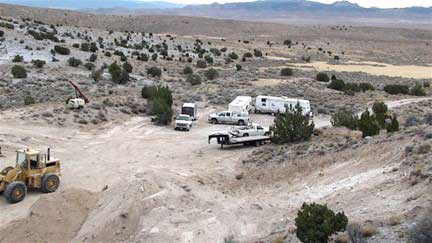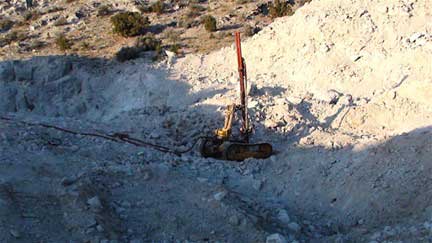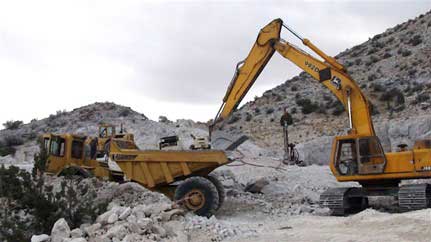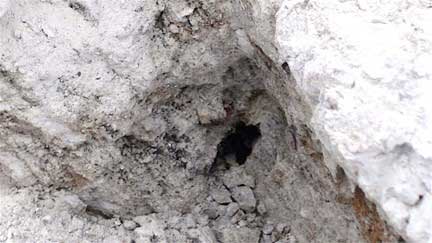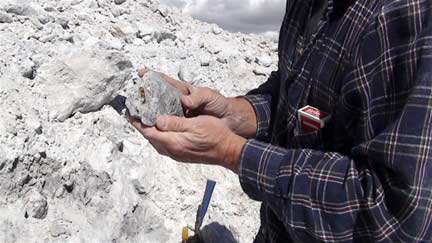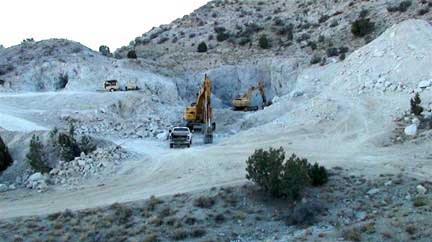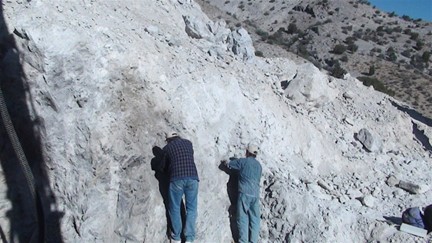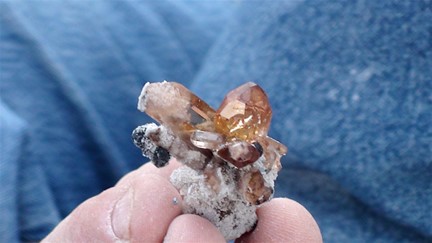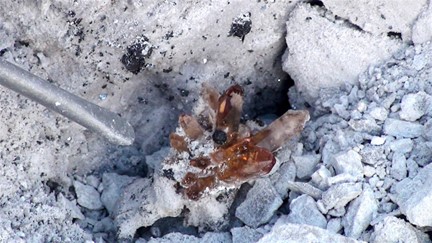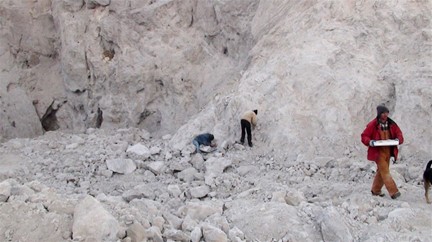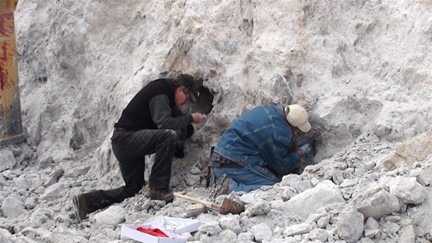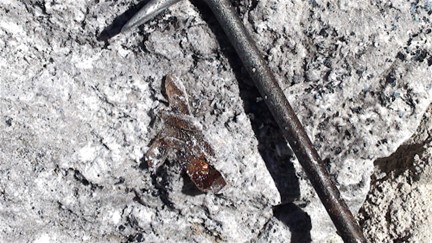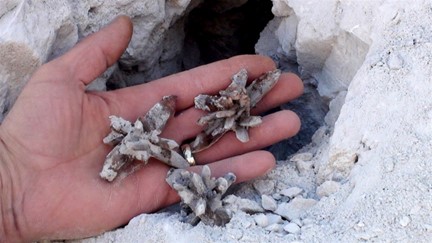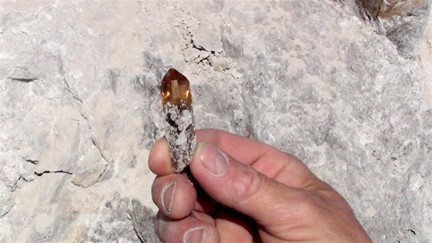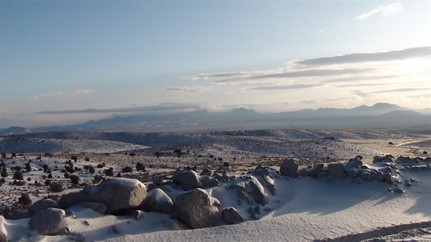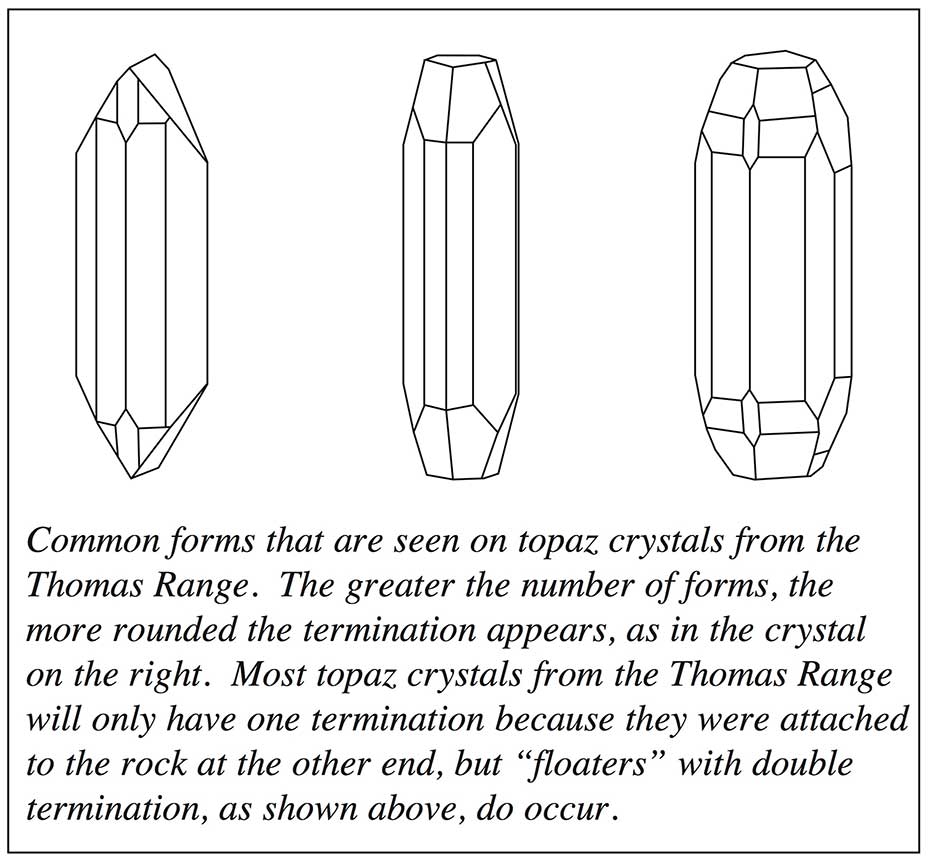Introduction
Topaz has been found around the world. However, the Maynard Claim in Utah is known for its imperial sherry color, though not all are of this color. It can range from deep sherry to colorless, from gem quality to those with sand inclusions. In 1969 topaz became the Utah State Gem. The following project review provides historical information concerning the topaz occurrence at the Maynard Claim and the efforts of Collector’s Edge Minerals, Inc. (CEMI) to conduct specimen mining and recovery from 2009 to 2010.
Location
The Maynard claim is located in the Thomas Range near Topaz Mountain, a remote area with no services, approximately 160 miles southwest of Salt Lake City, Utah. From the town of Lynndyl, Utah at the junction of U.S. Highway 132 and U.S. Highway 6, the area can be reached by traveling south on U.S. 6 for approximately 5 miles, then west for 37 miles on the paved Brush Wellman Road. From there a dirt road with a sign for Topaz Mountain leads to the area.
![]()
Map showing approximate location of Topaz Mountain within the State of Utah, USA.
Topaz Mountain area, from Wilson (1995)
History
The earliest reports on geology of the Thomas and Dugway Ranges are by Henry Engelmann, geologist for Captain J. H. Simpson’s expedition across the Great Basin in 1859 (Simpson, 1876, p. 325-326), and by G.K. Gilbert (1875, p. 27, 119), attached to Lieutenant G. M. Wheeler’s survey west of the 100th meridian. Engelmann briefly discussed the topaz from the Thomas Range; Gilbert., who went through Dugway Pass, mentioned the volcanic rocks and Paleozoic sedimentary rocks in the vicinity. (Staatz and Carr, 1964)
The discovery of fluorspar on Spor Mountain in 1936 eventually attracted considerable attention to that part of the Thomas Range. Between 1948 and 1950 the geology of this area was studied and some of the aRea mapped by W.P. Fuller for North Lily Mining Co., J. J. Beeson for Geneva Steel Co., and James Quigley for Chief Consolidated Mining Co. (Staatz and Carr, 1964)
History would not be complete without the mention of Maynard Bixby. Born in Pennsylvania to a storekeeper and his wife in 1853, he graduated from Lafayette College in 1876. In the early 1890s Maynard moved to Utah after his involvement, among other things, in mining activities in Colorado and Arizona.
Maynard spent considerable time prospecting the Thomas Range in Utah, staking numerous claims. Today, one of his claims, the Maynard Claim, is still a source of fine topaz crystals. Maynard is known for his discovery in 1904 of bixbyite and bixbite (a variety of red beryl). However, the bixbite was discredited since it sounded too much like bixbyite and is now referred to only as red beryl. Maynard died in 1935 after a notable legacy that included the discoveries discussed above, numerous articles and a book in 1902 titled “A Catalogue of Utah Minerals and Localities”.
Topaz Valley is one place in the Topaz Mountain area that has been mostly set aside by the BLM for hand collecting. Though much of the surface topaz has been collected over the years, some can still be found as it weathers out or by digging below the surface. However, good quality sherry-colored topaz crystals, for the most part, must be located by searching for pockets within the light gray rhyolite. Here they are found attached to the sides of the cavities as well as loose within them, often coated with a soft, clay-like material. However, if not protected from the sunlight, the topaz bleach, irreversibly, very rapidly from sherry to clear within a day when exposed to direct sunlight.
Collector’s Edge began mining on October 1, 2009 and continued through mid-December. Following are photos of the operation and some of the topaz found during this effort.
Geology
The rocks in the Thomas and Dugway Ranges have an age spread from Cambrian, about 540 million years ago, to recent. About half the area within the two ranges is underlain by Tertiary volcanic rocks and about half by Paleozoic sedimentary rocks. The basins surrounding the ranges are filled chiefly with Lake Bonneville gravel and marl of Pleistocene age. The Paleozoic sedimentary rocks include 26 formations ranging in age from Early Cambrian to Late Mississippian, and have a total thickness of at least 30,000 feet. The Prospect Mountain quartzite, at the base of the section, makes up at least 12,000 feet; the rest of the Paleozoic rocks consist chiefly of limestone and dolomite with lesser amounts of quartzite, siltstone, and shale. (Staatz and Carr, 1964)
The Paleozoic rocks are overlain by Tertiary volcanics that are divided into two groups. The older group is exposed chiefly in low-lying hills adjacent to the main volcanic mass and as intrusive bodies in the Paleozoic sedimentary rocks. The following 10 units are distinguished in the older volcanic group: rhyodacite; rhyodacite breccia and associated tuffs; plagioclase crystal tuff; black glass welded tuff; sanidine crystal tuff; quartz-sanidine crystal tuff; vitric tuff; red vitric tuff, conglomerate, and sandstone; porphyritic rhyolite; and intrusive breccia. The younger volcanic group unconformably overlies the older and makes up the greater part of the volcanic rocks exposed. This group consists of at least five overlapping units each made up of a sequence of vitric tuff, breccia and rhyolite; the rhyolite makes up at least 95 percent of each unit. All three rocks are cut by green-glass intrusives that probably formed in and near volcanic vents. (Staatz and Carr, 1964)
Three small sandstone units of varying composition are inter-bedded with the volcanic rocks and appear to be deposits formed in small lakes. Quaternary rocks consist largely of thick deposits of sand, gravel, clay, and marl laid down in Lake Bonneville, but also include a thin local cover of recent alluvium. (Staatz and Carr, 1964)
Rocks of Paleozoic age in the Thomas and Dugway Ranges in general strike north or northeast and dip at moderate angles to the west. The Paleozoic rocks are much faulted, particularly on Spor Mountain in the western part of the Dugway Range. Folding is unimportant, although there is one gentle syncline in the northeastern part of the Dugway Range. Three general groups of faults can be distinguished: (1) thrust faults, which are few in number and are the oldest, (2) normal and reverse faults of diverse trends, which are numerous and generally of small displacement, and (3) north- and northwest-trending Basin and Range faults, which are large and probably the youngest. (Staatz and Carr, 1964)
Topaz crystals are found in all rhyolite flows of the younger volcanic group. Distribution within the flows, however, is quite local and generally does not exceed several hundred square feet in any one area. Areas in which topaz crystals less than half an inch in length occur are fairly common, but areas in which larger crystals are found are rather scarce. Innumerable fragments of topaz crystals are found in many of the dry streambeds which head in the rhyolite. Topaz crystals are found in greatest abundance in Topaz Valley, and, in spite of all the collecting that has taken place, it is still one of the best sources of good specimens. (Staatz and Carr, 1964)
Both clear and opaque crystals are found in the Thomas Range. The clear variety occurs singly or in clusters in small cavities, some of which are found in the hollow centers of lithophysae. These crystals are generally attached at one end, the other end being well terminated. Doubly terminated crystals attached in the middle were found in a few places. Crystal faces are well developed, and Alling (1887, p. 146- 147) measured and described two pinacoids, b(010), c(001); two prisms, m(110), 1(120); a macrodome, d (201) ; two brachydomes, f (021), y (041) ; and four pyramids, i(223), u(111), o(221), e(441), on topaz from the Thomas Range. (Staatz and Carr, 1964)
Lithophysa is a felsic volcanic rock containing small spherical or lenticular cavities (lithophysae), caused by expanding gas in the tuffs and rhyolitic lavas before solidification. Mineral-bearing solutions under high pressure and temperature then permeated the rhyolite, following the more porous zones, allowing crystal growth in those places where cavities formed.
Lithophysae, from about 1/4 to 8 inches in diameter, are locally abundant, particularly in Topaz Valley. The lithophysae are spherical and consist of a series of thin concentric shells of rhyolite separated by hollow spaces. The shells are mostly incomplete and tend to coalesce at one end. Some of the lithophysae have hollow centers. Small crystals of topaz, quartz, or sanidine commonly protrude into the hollow spaces at the center and between the shells. Locally, and especially in Topaz Valley, the rhyolite contains small cavities or vugs as much as 1-1/2 inches in diameter, which contain well-developed crystals of topaz, specularite, quartz, pink beryl, bixbyite, garnet, and pseudobrookite that have aroused the interest of mineralogists and mineral collectors. (Staatz and Carr, 1964)
Many clear crystals, when broken out of the rhyolite, are pale amber, but on exposure to sunlight, fade and become colorless. A few rose and amber topaz crystals, which had not faded, were found at the north end and on the east side of the Thomas Range. Similar rose topaz is reported (Montgomery, 1934, p. 87) from the east side of the Thomas Range just north of Pismire Wash. The topaz crystals vary in size but most of them are half an inch or less in length (along c axis). The largest clear crystal known measured 2 inches in length and five-eighths of an inch across its greatest width. It was collected from near the center of Topaz Valley (Buranek, 1947, p. 38). (Staatz and Carr, 1964)
The opaque topaz is light gray to nearly black. Some of the crystals are in solid rhyolite, while others are partly in cavities. The crystals appear to have grown in the rhyolite and to have incorporated parts of the rhyolite as they grew. Patton (1908, p. 185) investigated these crystals in thin section; he noted that the interiors are crowded with quartz grains averaging 0.05 mm in diameter and that the feldspar so common in the surrounding rhyolite is missing. Patton’s findings suggest that a reaction of fluorine-rich fluids with the feldspar formed topaz and quartz in some manner similar to the formula (Staatz and Carr, 1964):
8KAlSi308(sanidine)+2F2 +2H20 to 4[Al2(F,OH)2Si04] (topaz)
+20SiO2(quartz)+4K20+02
All gradations occur between clear and opaque crystals, and some crystals are clear at the ends that protrude into cavities but are opaque where they are attached to the sides of the cavities. In general, opaque crystals are larger than clear crystals and are commonly an inch or more in length. Opaque crystals tend to have simpler forms, and the prism, m(110), is the most common. In some specimens a second prism, 1(120), is present, and if terminated, the form is generally a simple pyramid, u(111). The opaque crystals occur in certain localities, just as the clear crystals do, and in some places the two are found together. (Staatz and Carr, 1964)
Topaz: Al2(SiO4)(F,OH)2
Though the topaz can be found in beautiful sherry or amber colors, it will lose its color when exposed to sunlight over time. Care must be taken to keep specimens out of direct sunlight; however, exposure to radiation will restore the color.
Other Minerals
Beryl
Red beryl crystals, up to a ¼ inch, have been found in cavities at Topaz Mountain, but they are considered extremely rare. Red beryl was first discovered here by Maynard Bixby in 1904.
Bixbyite: Mn23+O3
Bixbyite occurs in shiny, black cubes up to ¼ inch. Topaz Mountain is the type locality for this mineral that was named after Maynard Bixby who first discovered them here in 1904.
Cristobalite: SiO2
Cristobalite is a polymorph of quartz and has the same formula, but a different crystal structure, forming as octahedral or spherulites.
Cassiterite: SnO2
Cassiterite is a primary ore of tin.
Durangite: NaAl(AsO4)F
Garnet: Fe32+Al2(SiO4)3; Mn32+Al2(SiO4)3
Garnet, almandite and spessartite, ¼ to ½ inch in size, is rarely found here and occurs in a reddish brown color, often in clusters.
Hematite: Fe2O3
Pseudobrookite: Fe2TiO5
Pseudobrookite is quite rare, black in color, and forms in needlelike, radiating clusters up to 1 inch in length.
Quartz: SiO2
Quartz is quite common, but generally overlooked since they are quite small (to 5 mm) and thought to be topaz.
Current Status
CEMI currently has no future plans to conduct mining at the Maynard locality. Visitors should be advised that much of the area is under claim and collecting without permission is highly discouraged.
References
Alling, A. N., 1887, On the topaz from the Thomas Range, Utah: Am. Jour. Sci., 3d ser., v. 33, p. 146-147.
Buranek, A. M., 1947, Notes on topaz and associated minerals of Topaz Mountain and adjacent areas, Utah: Utah Mineralog. Soc. Bulletin, v. 7, p. 36-43.
Gilbert, G. K., 1875, Report on the geology of portions of Nevada, Utah, California, and Arizona examined in the years 1871 and 1872: U.S. Geog. and Geol. Surveys W. 100th Meridian Rept., v. 3, p. 17-187.
Montgomery, Arthur, 1934, A recent find of bixbyite and associated minerals in the Thomas Range, Utah: Am. Mineralogist, v. 19, p. 82-87.
Patton, H. B., 1908, Topaz-bearing rhyolite of the Thomas Range, Utah: Geol. Soc. America Bulletin, v. 19, p. 177-192.
Simpson, J. H., 1876, Report of exploration across the Great Basin of the Territory of Utah for a direct wagon-route from Camp Floyd to Genoa in Carson Valley in 1859: Engineer Dept. U.S. Army, Washington, 518 p.
Staatz, M.H. and Carr, W.J (1964) “Geology and Mineral Deposits of the Thomas and Dugway Ranges Juab and Tooele Counties Utah, Geological Survey Professional Paper 415, pp. 8-
Wilson, James R. (1995) “A Collector’s Guide to Rock, Mineral & Fossil Localities of Utah, Miscellaneous Publication 9504, Utah Geological Survey, pp. 89-93.


